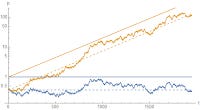DSGE, part 3 (stochastic interlude)
So far, I've left out the stochastic terms (the S in DSGE) in this series (part 1, part 2). I'd like to show how it would appear in the information equilibrium models. Let's start with the NK IS curve:
$$
y_{t} = -\frac{1}{\sigma}\left( i_{t} - E_{I} \; \pi_{t+1} \right) + E_{I} \; y_{t+1}
$$
Per part 2, we should interpret the expectations operators (the $E$'s) instead as "information equilibrium" values (we can use the use the same letter $E$ to which I affixed a subscript $I$ above). Actually, we should interpret every variable in the equation as the information equilibrium values:
$$
E_{I} y_{t} = -\frac{1}{\sigma}\left( E_{I} i_{t} - E_{I} \; \pi_{t+1} \right) + E_{I} \; y_{t+1}
$$
If we want to use observed values at the present time index $t$, we need to account for a deviation $n$ due to non-ideal information transfer
$$
x_{t} = E_{I} x_{t} - n_{t}
$$
This deviation can look very much like a traditional stochastic process:


Substituting and collecting (as $\nu$) these stochastic terms introduced by removing the $E_{I}$ operators at the current time index $t$ (but not for future ones since we don't know what the values are), we obtain the traditional DSGE form of the NK IS curve:
$$
y_{t} = -\frac{1}{\sigma}\left( i_{t} - E_{I} \; \pi_{t+1} \right) + E_{I} \; y_{t+1} + \nu_{t}
$$
The stochastic piece is the deviation from ideal information transfer and maximum entropy.
...
Update
Here's the summary with links to each part.



